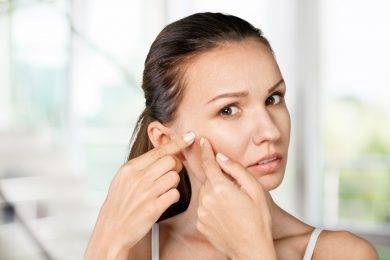You’re not alone if you see acne when you look in the mirror. 85% of young people between the age of 12 and 24 suffer from this frustrating condition.
You may notice that your acne forms in a specific part of your face. One of the most common places to find acne breakouts is your cheeks.
Before treating your cheek acne, you’ll need to get to the root of what’s causing it. When you identify the problem, you can make a targeted plan to treat it.
Our helpful guide goes over the top five causes of cheek acne and what you can do about it.
Types of Acne
Many people use acne as a catch-all for all the different bumps on the skin. There are actually several types of acne that you can find on your cheeks and other parts of your body.
Blackheads
You’ll know you have blackheads if you see tiny black dots on your skin. This happens when a pore gets filled with dirt.
Cysts
If you have a blockage that forms deep in the skin, it can turn into a cyst. These look like hard nodules and can damage the healthy skin you have.
Papules
These are blemishes that show up on the surface of the skin. They usually look like small red bumps and don’t have a white head.
Pustules
If you see a pimple with a white head in the center, you are dealing with a pustule. Resist the temptation to pop these as that can leave scarring.
Causes of Cheek Acne
While it can sometimes be tricky to nail down exactly what is causing your cheek acne, there are a few common culprits to look at.
1. Your Cellphone
If you have a cellphone, chances are you bring it everywhere. The locations your phones go and your constant touching of it can cause bacteria to build up on the case. When you get a phone call, your phone touches your face and transfers this bacteria to your skin.
Because most people don’t clean their phone that often, the bacteria that builds up on it can cause your pores to clog. Clogged pores on your cheeks are a recipe for cheek acne.
2. Touching Your Face
It can be hard not to touch your face throughout the day, but this is one of the biggest causes of cheek acne. Your fingers touch a lot of bacteria-covered objects each day. Whenever you touch your face, you are putting bacteria on it.
You may not think it will be hard to stop touching your face, but it’s more challenging than you may think. Once you’re aware of touching your face, it will be easier to stop the habit.
3. Dirty Sheets and Pillows
Another place that can house lots of bacteria is the pillows and sheets you lay on every night. If you aren’t good at cleaning your bedding, they could be causing acne on your cheeks.
When you toss and turn at night, your face will rub on your pillowcase. All that friction can cause your face to break out.
4. A Lack of Skincare Routine
One way to keep your skin looking clear is by following a skincare routine. Using harsh or cheap chemicals can cause your skin to break out.
If you wash your face with too much force, you can make acne occur. The friction from rubbing your face with a washcloth will do more harm than good.
Not washing your face frequently can also cause your cheeks to break out. If you skip the face wash, bacteria and oil can build up in the pores of your skin. If it isn’t removed, it can lead to breakouts.
5. Changes in Hormones
Hormones are a big reason that acne can pop up on your face. Androgens are hormones that your body produces. Many different reasons cause these hormones to fluctuate.
Pregnancy and menopause cause an increase in androgens. Menstrual cycles are another cause for the rise of androgens.
When androgens are released, they cause an increase in an oil called sebum. If your skin has too much sebum in it, it can produce too much oil and break you out.
How to Treat Cheek Acne
If you suffer from cheek acne, you can do a few things to get it under control. Some treatments are over-the-counter, and others you can get from a dermatologist.
There are three acne-fighting ingredients you can use to stop many types of acne from forming. Benzoyl peroxide and salicylic acid are two treatments you can buy at a drugstore. If you want a stronger retinoid for your cheek acne treatment, your dermatologist can help you out.
When you’ve resolved your acne, you may be left with post-acne marks. Click here to learn tips on how to fade them.
Preventing Cheek Acne
You can do a few things to keep cheek acne at bay.
Although it can be annoying, wiping down your phone each day will help keep acne from forming on your face.
When you’re in the bathroom, do you find yourself playing on your phone? If so, this is one habit you have to break. Bathrooms are teeming with germs, so keeping your phone away from here will help keep it clean.
It would help if you changed your sheets every week. Make sure your pillowcases get changed weekly too. Keeping an extra pillowcase on hand will make it easy to swap it out.
Touching your face is inevitable. Keeping your hands clean will help stop bacteria from getting onto your skin.
Resolve Your Cheek Acne With Some Simple Steps
Once you’ve figured out the causes of cheek acne that are plaguing you, you’ll have the tools you need to help it. Remember that it takes time for your acne to go away once you’ve started treating it. With some patience, you’ll be back to having clear skin again.
Your skin isn’t the only thing you need to keep healthy. Check out our other health and lifestyle blogs today for other tips and tricks!











